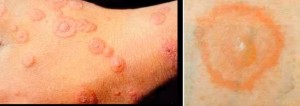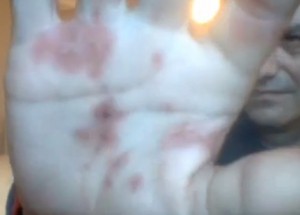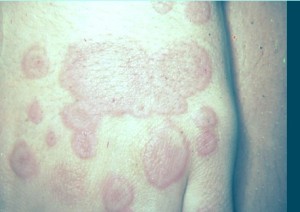EM or erythema multiforme is a condition wherein extremely sensitive skin reacts unusually and causes the appearance of lesions. Such a reaction of the skin is normally an effect of infection of the body with the herpes simplex virus. The skin disorder often affects the mucous membranes. It is severe, self-limiting and generally tends to fade away without causing any medical problems.
Erythema multiforme is dissimilar from other diseases which cause analogous reactions like Toxic Epidermal Necrolysis or TEN, and Stevens Johnson syndrome or SJS. It is classified into minor and major kinds and can affect people belonging to both genders and various races. However, it predominantly occurs in males as well as those between 20 to 40 years of age.
Erythema multiforme has a propensity to occur more frequently when certain genetic conditions are present. It may be noted that the chances of finding certain forms of tissues is greater in those with herpes. For example, Recurrent EM (-DQB1*0301, -A33, -DR53, -B35, HLA-B15) and Associated EM (HLA-DQw3).
Symptoms of erythema multiforme
Prodromal symptoms generally cannot be observed in cases of erythema multiforme minor. However, one may see mild signs such as fever, joint pain, general weakness and chills in those with erythema multiforme major.
Skin abnormalities:
- Within a period of 24 hours after being affected by EM, some or many lesions may form. At first, the lesions can be seen on the upper part of the feet and/or on the back portion of the hands, after which they spread to other areas. Other common regions affected by erythema multiforme include the elbows, knees, neck, face and torso. The lesions sites may be prone to burning sensations and itching.
- During the initial stages, the lesions are flat, do not occur in groups, and are red or pink in color, after which they slowly elevate and become bigger to develop in to papules. Later, they may convert into patches of plaques which have a darkened center and are prone to blister and crust over.
The erythema multiforme lesion which can be usually seen is circular with distinct borders and 3 concentric parts, i.e.
- A dark reddish center with blister crust
- The concentric circle covering the center is pinkish and elevated because of swelling and occurrence of fluids
- The final circle is bright reddish
The not so common EM lesions may contain 2 zones with no specific margins
A doctor may need to conduct a complete investigation of the skin to specify the lesion formation stage. The rash areas may not be inflamed or swollen up. But the lips may become swollen in case of erythema multiforme major.
Mucous membranes involvement:
- Erythema multiforme lesions that affect the mucous membranes usually develop, a few days post skin rash formation.
- In instances of ED minor, the occurrence of mucosal lesions may be absent or they may be mild in nature. The initial symptoms of mucous membrane involvement include increased redness inside of the cheeks and of the lips, with occasional formation of blisters that burst and convert into ulcers.
The various mucous membranes affected by EM major include the:
- Trachea/bronchi
- Genitals or anus
- Eyes
- Gastrointestinal tract
- Lips, inside of the cheeks, or tongue
- In rare cases, the gums, palate, and floor of the mouth may be affected
The lesions of the mucous membranes experience swelling and reddening along with blister formation. Such blisters have a tendency to rupture and develop into superficial, painful ulcers that are surrounded with white pseudomembrane. Patients can experience swallowing and speaking problems due to occurrence of swollen lips with hemorrhagic crusts.
Mycoplasma pneumonia affects only the mucous membranes and extreme cases may need hospitalization
Erythema multiforme reoccurrence:
A patient can experience the recurrence of Erythema multiforme many times in a year and the condition may continue for a number of years. HSV-1 infection is believed to be the primary cause of such EM reoccurrence
Causes of erythema multiforme
- Erythema multiforme is mostly caused due to infections, with the main cause being infection by herpes simplex virus. EM is often activated by herpes labialis infection and occasionally by infection with genital herpes. HSV type 1 infection is the primary culprit as opposed to HSV type 2 infections. The herpes infection occurs first which later triggers formation of skin rashes in three to 14 days.
- Other viruses responsible for causing erythema multiforme include Hepatitis viruses, Herpes varicella zoster, Adenovirus, HIV, Viral vaccines, Parapoxvirus, and Cytomegalovirus.
- Mycoplasma pneumonia, a lung condition caused by Mycoplasma pneumonia can also cause or trigger the onset of erythema multiforme
- A few cases of erythema multiforme have been found to be triggered as a reaction to certain medications including barbiturates, phenothiazines, sulphonamides, penicillin, NSAIDs and anticonvulsants
Treatment of erythema multiforme
- A majority of erythema multiforme cases vanish without treatment.
- Oral acyclovir can be given to treat HSV infection, while antibiotics are given to cure Mycoplasma pneumonia
- Hospitalization of the patient may be required to overcome drinking and swallowing difficulties
- Oral pain and infection can be reduced with antiseptic mouth wash and local anesthetic
- Topical corticosteroids or oral antihistamines can provide relief from itching
- Eye problems have to be treated by an eye doctor
Erythema Multiforme Pictures



Wonderful beat ! I wish to apprentice at the same time as you amend your website, how can i subscribe for a blog website? The account helped me a acceptable deal. I had been tiny bit acquainted of this your broadcast offered bright clear idea